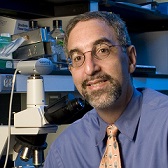Neurofibromatosis
Identification of Novel Therapeutic Targets for NF1 Optic Pathway Glioma by Examining the Tumor as an Ecosystem



Posted January 16, 2018
David H. Gutmann, M.D., Ph.D., Washington University in St. Louis

David H. Gutmann, M.D., Ph.D., Washington University in St. Louis
Neurofibromatosis type 1 (NF1), caused by mutations in the NF1 tumor suppressor gene, can manifest in patients in different ways, one of which is the growth of low-grade gliomas of the optic pathway (OPGs). These tumors grow slowly, are heterogeneous, and develop during childhood, making them difficult to treat with chemotherapy. Dr. David Gutmann received a fiscal year 2012 Investigator-Initiated Research Award through the Neurofibromatosis Research Program to study the tumor "ecosystem" - the tumor cells and microenvironment of OPGs, and their interactions - to discover novel therapeutic targets for treating these gliomas.
In 2015, Dr. Gutmann's group published a report [3] demonstrating the isolation and characterization of cancer stem cells (CSCs) from low-grade gliomas from Nf1+/- mice with somatic Nf1 gene inactivation in their neuroglial progenitor cells. The low-grade gliomas that develop in these mice are similar to those seen in humans. These CSCs were found to express CD133, as well as other markers identified on CSCs in other brain tumors; non-tumor control cells did not express these markers. The CSCs isolated also exhibited other characteristics of stem cells, such as ability to differentiate, proliferate, and self-renew. When injected into the brainstems of Nf1+/- mice, these cells were able to form glioma-like lesions. Interestingly, injection of the optic glioma stem cells into athymic mice did not give rise to gliomas, underscoring the importance of the Nf1+/- microenvironment to tumor formation. Further studies indicated that these CSCs are resistant to some treatments, including carboplatin, which is a currently-used treatment for OPGs.
In one of his group's most recent publications [2] from this project, the investigators examined the cell of origin of optic gliomas in two different mouse models, one in which somatic Nf1 mutation occurs in oligodendrocyte precursor cells (Olig2+ cells, OPCs) and another one in which neural progenitor/stem cells (GFAP+, CD133+ cells) undergo somatic Nf1 loss. Both sets of mice developed gliomas, but the gliomas derived from the GFAP+ and CD133+ cells developed by 3 months of age, whereas the gliomas derived from the OPCs developed at 6 months of age, even though Nf1 is lost at similar times during development in the two mouse models. These findings suggest that the time to tumorigenesis may be due to differing cells of origin.
Dr. Gutmann's team also published a recent study [1] focused on characterizing the tumor as an ecosystem. Using mouse models with different Nf1 mutations and cells of origin, the group performed RNA-sequencing of the whole tumor. While the optic gliomas in the various mouse models all looked similar with immunohistological analysis, the RNA-sequencing analysis showed distinct molecular signatures. Further investigation revealed that the gene expression pattern observed in the tumor reflected the intercellular interactions within the tumor, not the individual cell types, highlighting the importance of considering the tumor as a whole. The group also found that the different mouse models all share a core gene signature that distinguishes tumor tissue from non-tumor tissue, and pursued this signature as a marker for response to drug treatment. In these studies, neither carboplatin nor rapamycin treatment resulted in significant changes in the tumor signature; however, minocycline treatment, which targets microglia, shifted the gene signature towards the non-tumor tissue signature.
Dr. Gutmann's studies under this award have led to greater knowledge of the cellular components and the importance of their interactions in optic glioma development. The findings from his group have laid the groundwork for future studies into potential biomarkers for effectiveness of treatment and prognosis for NF1 patients. These studies have also pointed to novel targets for optic glioma treatment and provided mechanistic insights into drug resistance to currently-used treatments.
Publications:
[1] Pan Y, Bush EC, Toonen JA, Ma Y, Solga AC, Sims PA, and Gutmann DH. 2017. Whole tumor RNA-sequencing and deconvolution reveal a clinically-prognostic PTEN/PI3K-regulated glioma transcriptional signature. Oncotarget 8(32):52474-52487.
[2] Solga AC, Toonen JA, Pan Y, Cimino PJ, Ma Y, Castillon GA, Gianino SM, Ellisman MH, Lee DY, and Gutmann DH. 2017. The cell of origin dictates the temporal course of neurofibromatosis-1 (Nf1) low-grade glioma formation. Oncotarget 8(29):47206-47215.
[3] Chen YH, McGowan LD, Cimino PJ, Dahiya S, Leonard JR, Lee DY, and Gutmann DH. 2015. Mouse low-grade gliomas contain cancer stem cells with unique molecular and functional properties. Cell Rep 10(11):1899-1912.
Link:
Last updated Monday, March 10, 2025














